Disclosure: Meeple Mountain received a free copy of this product in exchange for an honest, unbiased review. This review is not intended to be an endorsement.
It’s Good to be Bad
Enter into the Lovecraftian doom and gloom and rise above your fellow cult leaders as the one true evil high priest to rule them all! The name of the game is Evil High Priest and, as the name implies, you are not a good guy. So off you go to break an Old One out of their eternal slumber, hoping that you do the best job at being the worst. So how does a cultic upstart such as yourself go about ending the world and becoming the most favored of an old god? I’m so glad you asked.
Have Cultists, Will Chaos

Evil High Priest is a worker placement game for 2-5 players that has been curated into the beautiful Lovecraftian world of Sandy Petersen. This title is created by his son, Lincoln, and is seeping with cultic themes, gorgeously gloomy art, and a great table presence. Each player controls a small cult working to release a Great Old One from its imprisonment by breaking the elder signs that hold it hostage. Once the old god is freed, the game ends and each player is rewarded for how many of the various resources they were able to collect and hold onto by the end of the game. With a great mix of worker placement locations and a great take on “base defense” Evil High Priest is a cult classic title that is sure to impress. (Disclaimer: I did “upgrade” the workers in this game from the base wooden ones to some leftover from my Cthulhu Wars set.)
Gameplay is played over a series of rounds with each player placing their workers and resolving locations until everyone has expended their available cultists. After a board reset, play restarts with players placing in this fashion until the Great Old One awakens. The turns are incredibly short with minimal downtime since, as with all great worker placement games, the meat comes from the various locations and placement options.
Are you on Board?
Evil High Priest has a plethora of boards that nicely divide and define the placement options for your villainous troops. Let’s discuss these locations and how they mesh together so nicely.
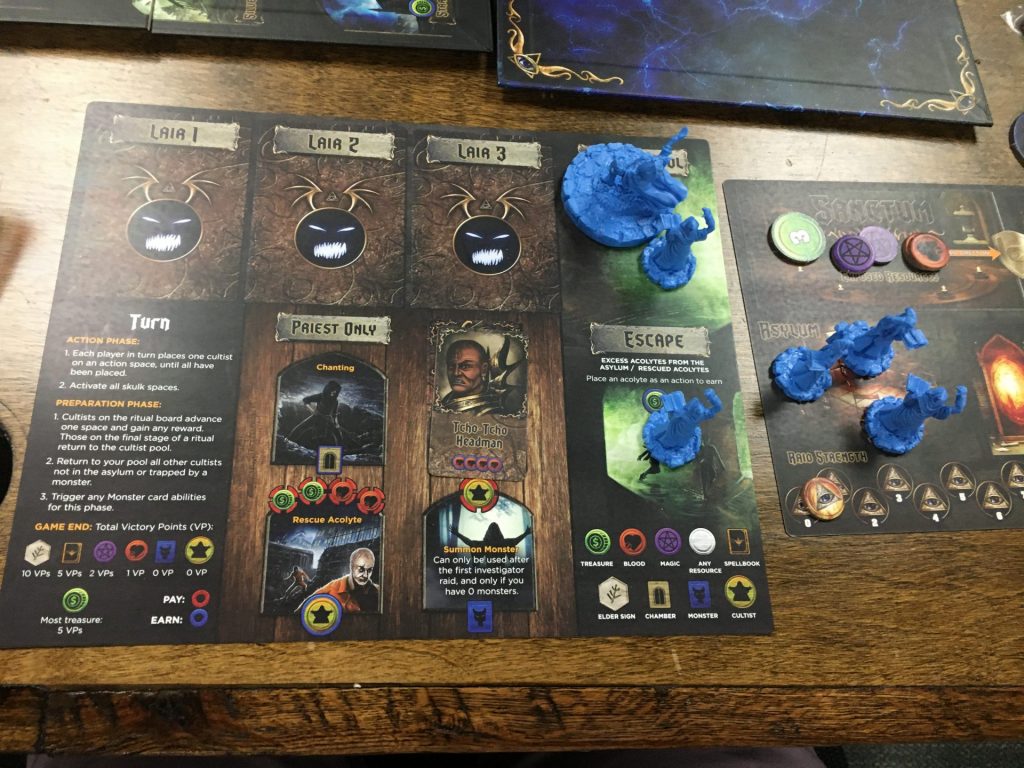
First is your Priest board. This is your base of operations and contains your repository of unused workers as well as your “high priest only” action spaces. Each player controls one high priest and between 2-5 cultists who can be placed on these various locations. Your high priest is just a bit more special as only they can go on one of the four special spaces on your home board. Three of these actions are generic to each player but the fourth is specific to the high priest you are playing. These actions are key to your success and will help you free cultists from the asylum for use, or gain monsters or dungeon rooms to help protect your resources from investigator raid.
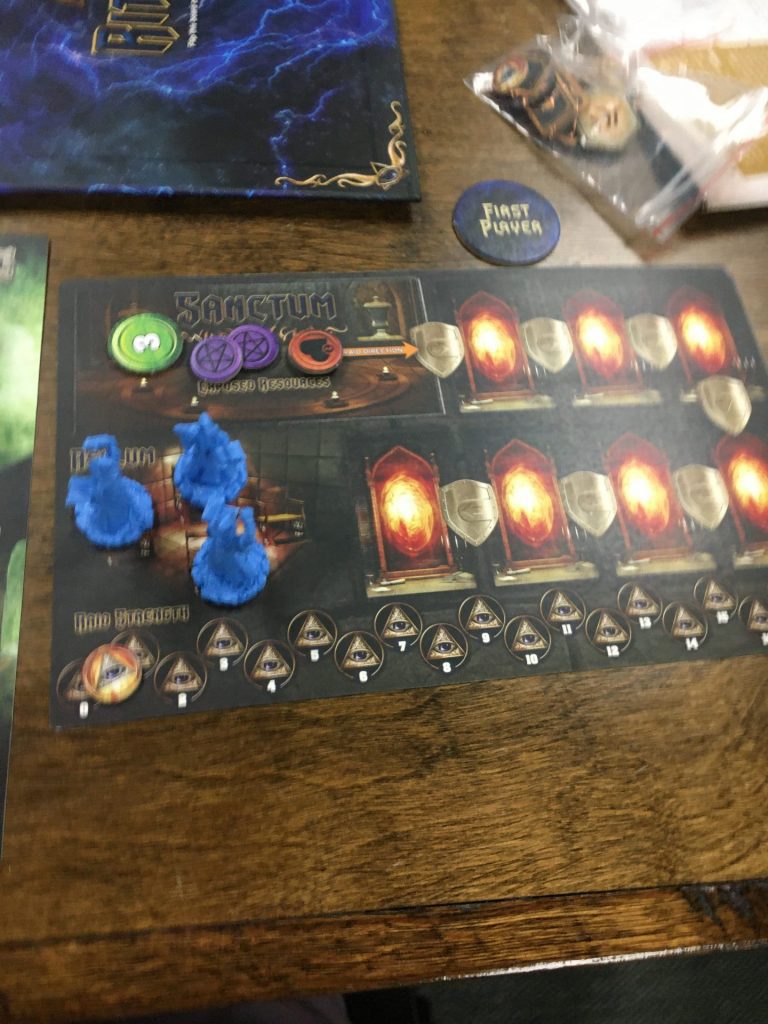
Speaking of your dungeon, that is located on your Sanctum board. Each player has their own dungeon where they store and protect the resources they collect. Throughout the game, as players continue to awaken the Great Old One, investigators will attempt to raid players’ dungeons to stop the cultists. We will talk about this in detail a bit later, but it is important to know that whatever resources are left unprotected are destroyed and sent back to the reserve. Since resources are points in Evil High Priest, it is important to protect your hoard from those pesky investigators.
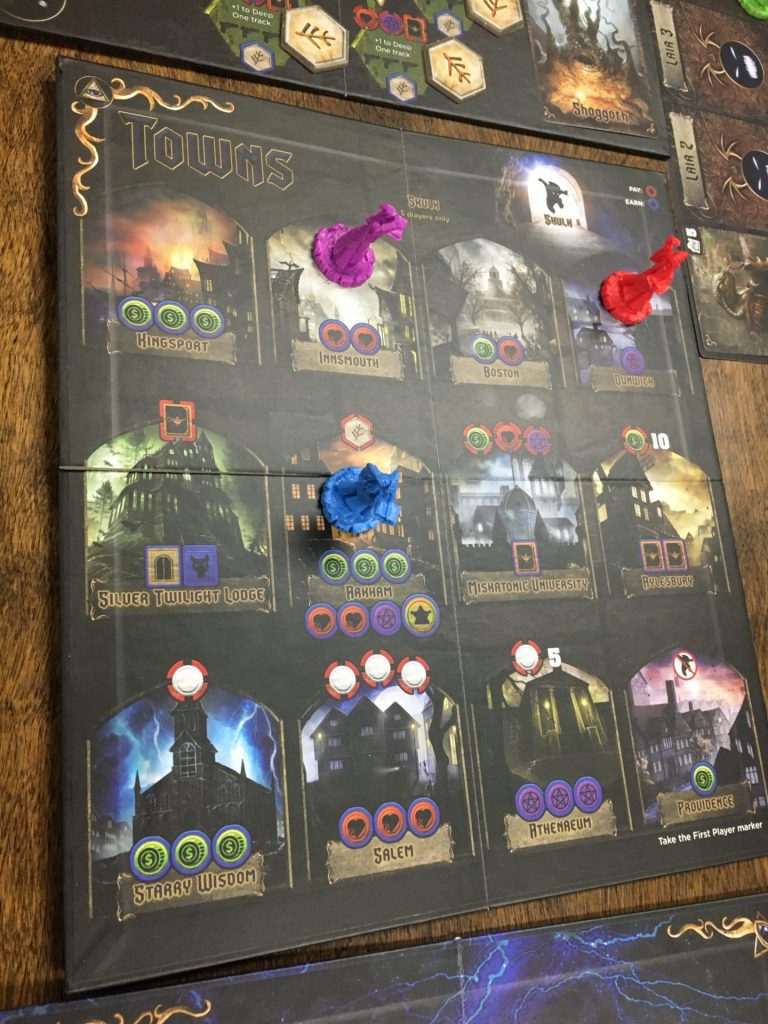
Second, let’s take you to the Town board. Here your cultists will be able to travel far and wide to prepare the wakening of your old god. Players can place their workers on these spaces to collect various resources they will need to break the elder signs. It is important to note that there can only be one unit (cultist or high priest) per space at any time. This makes placement a huge part of your strategy as, if a space you wanted is taken, there are limited options you can do to amend that. There is one work around if you are fortunate enough to get it and that is the skulking space at the top right of this board. If you place your cultist here, you will have to wait until every other cultist is on the board, but then you may place them in any space on the board regardless of whether it is occupied or not. You cannot use this space to steal the first player marker but otherwise this opens up your options.
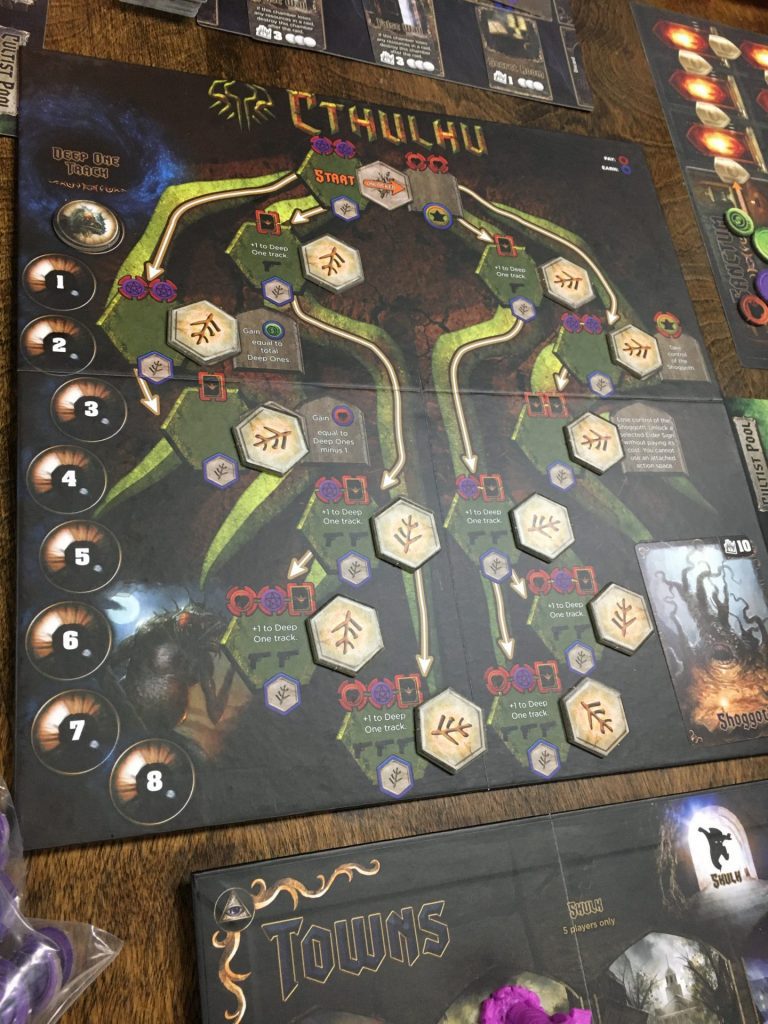
Third, let’s go to the Great Old One board. This board is entirely unique for each and every old god in the game but they follow a similar feel. Each old god is being held in place by 13 elder signs and it’s your job as dedicated crazy people to break those seals by paying whatever cost is associated with each seal. These boards start from a single point and branch out down different “trees.” You can only act and interact with those next in line from what is already unlocked. Many of these sign spaces also have some sort of boon attached to them so even once the sign is broken you can still place units here to gain whatever those rewards may be. As the game rages on you will find new and more powerful options available here to you as your god grows closer to awakening.
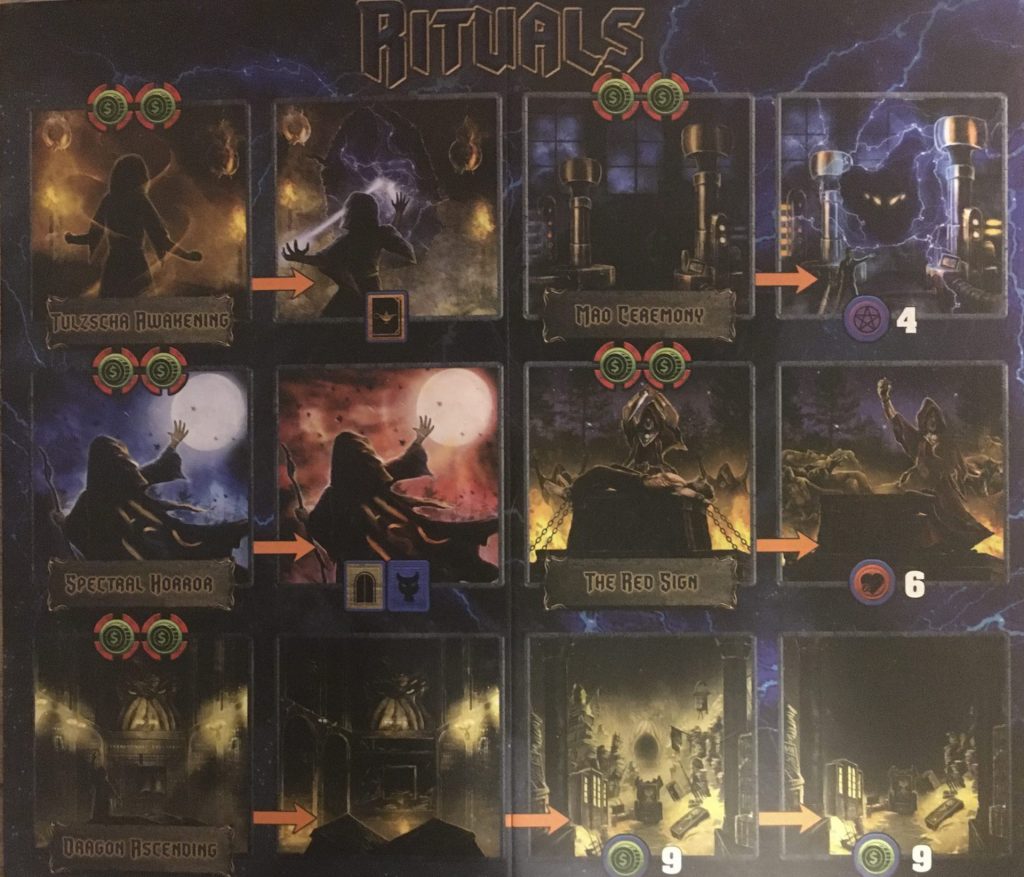
Once the first seal is broken on your Old God board, you gain the power to start performing rituals which, you guessed it, has its own board. This fourth board is face down at the start of the game and is only turned up after the first elder sign is claimed. Rituals allow you to place your cultists on long-term missions of sorts that will tie them up for 2-4 rounds of play. The rewards are great compared to the cost, but it is a bit of a time investment so you will want to make sure you do not leave yourself high and dry on units to utilize those valuable resources your cultists are off collecting for you.
There is one final board in the game, but it does not have worker placement spaces. This board simply holds the “shop” of available monsters, dungeon room cards, and potential lead investigators who will lead an upcoming raid. All of these items pertain to your dungeon and raids so let’s discuss those in more detail now.

Breaking certain elder signs will cause a raid to occur. When this happens, a die roll will determine which investigator is leading the raid. Raids vary in strength from 1-3 dice. For instance if this was a two dice raid, you would roll 2 six-sided dice and determine the value (the strength of the raid). Each player now needs to resolve this raid against their own defences. Initially, players can decrease the raid strength by 2 for each cultist in their asylum. They can also send a cultist that is free to the asylum to decrease the strength by 3. If the raid still has strength left, a player may sacrifice any monster they control to reduce their strength by the printed amount on the card. A player may hold up to 3 monsters and all monsters are a one-time use to weaken raids. If any strength remains, that player will lose all of their unguarded resources. The raid will then follow that path to the right, losing strength equal to the printed value on the cards. The raid will destroy every resource it finds along the way until it completes the path or runs out of strength.
As you can see, protecting your resources behind tough defences is key to being victorious in Evil High Priest. There is nothing worse than sliding into the end game only to have a last round 3 dice raid sneak past your defences and eradicate your hoard of valuable resources. This boss monster-esque addition to the worker placement formula is a huge win in my book.
Now, armed with your knowledge of the various boards on which you will battle for supremacy, set forth my fellow cultists and may the best high priest win!
Time to get your Cult on!

Evil High Priest plays smoothly at varied player counts and combines elements of worker placement, resource collection and, more uniquely, resource protection into one fun Lovecraftian brew. The presentation and theme of the game is spot on and the asymmetry that comes from not only you as the player, but also from whatever Great Old One you are trying to raise gives Evil High Priest a great deal of replayability. Turns, rounds, and even end game scoring are painlessly quick and seamless. This allows players to get into the fun part of a worker placement game: placing workers. Locations on the various boards are varied and engaging. There are several options to gain the resources needed and finding the optimal or remaining paths was an enjoyable process.
On the topic of resources, I did feel that from time to time, the slog of resource swapping was a bit tedious. Collecting blood, treasure, and magic simply to trade them for spellbooks did, at times, feel tedious but that is a small dent in Evil High Priest’s otherwise shiny chassis. On the other hand, I loved the resource defenses mechanic. The base defense was fun and engaging as I plotted out how to best defend my wares from those pesky investigators.
I will note that some of the unique high priest abilities seemed far more powerful than some others, even for an asymmetrical game. While many abilities focused on a very powerful resource grab or exchange, some implemented a “take that” mechanic. In one game, two players had a very powerful ability to steal my dungeon rooms or initiate additional investigator raids and I felt frustrated that I had very limited recourse for this. This is a small gripe since I may not have enough experience to understand the balance of these things yet. It is a simple fix to simply “not choose” those few priests during setup.
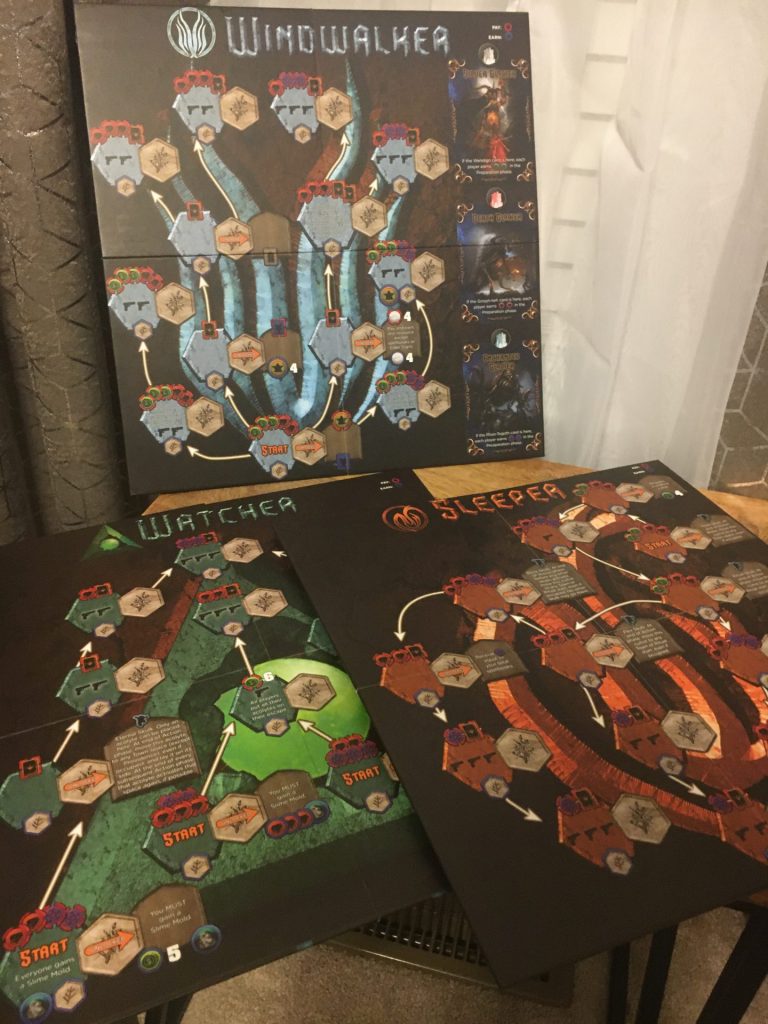
The gods themselves felt varied and satisfyingly themed. The inclusion or absence of the various elements they introduced was a huge hit in my book. As a Lovecraft fan and specifically an avid fan of Cthulhu Wars, Evil High Priest fit so nicely into the same universe and warmed my evil cultic heart. The Petersen family brand is alive and well with generations of designers showcasing their skill and ability to blend trusted, inventive mechanics together and merge them with quality, thematic lore, and background. If you are looking for a new, dark worker placement game, Evil High Priest is sure to be a hit with your group.
Evil High Priest
Genre: Worker Placement
Pros: Unique boards for asymmetry, Resource defense, Rich theme
Cons: Resource exchange grind, Has some “take that”
Rating: 8/10 A great worker placement title with a lot of replayability.


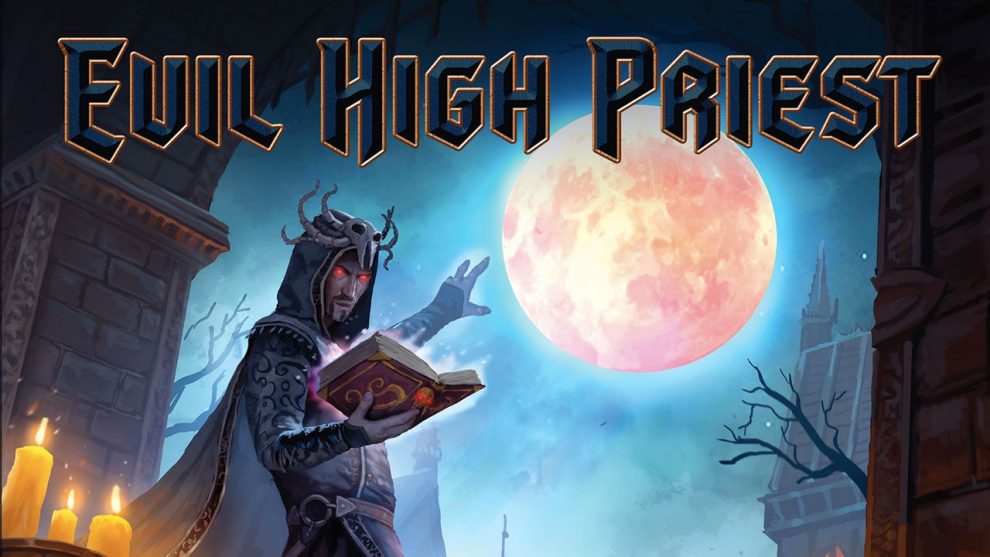


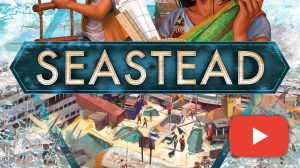
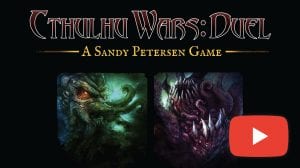




I read some H. P. Lovecraft back in the day. I am *not* what you would call an uber fan of the literature or the multitudes of spinoff products that have come over the years. I have played a few games in the vein (e.g., Elder Signs, Cthulhu Wars, etc.)
I have friends who *are* uber fans of the stuff; guys who probably have Sandy Peterson’s phone number memorized. I reached out to one of them after reading this review and yes, they have this game and they love it. Which means, after this pandemic is over, I will get a chance to play this a few times. 🙂
Thanks for the review. It was a fun read!